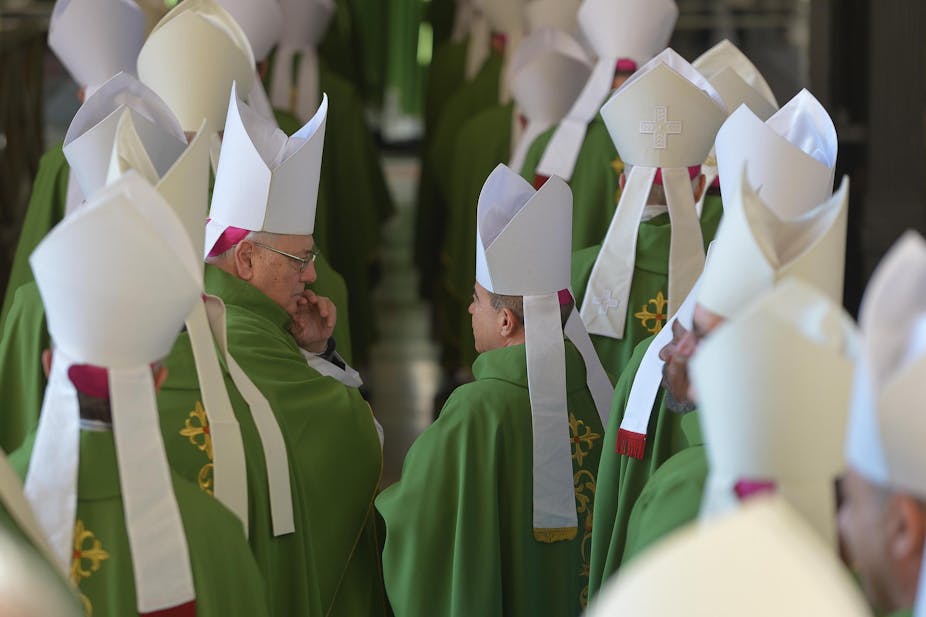The Extraordinary Synod on the Family, convened by Pope Francis in Rome from October 5 to 19, was intended to open up an honest and wide-ranging debate about the Catholic Church’s teaching and pastoral practice on difficult aspects of marriage and family life.
While new initiatives on homosexuality, divorce and remarriage and civil unions might not all have made it into the Synod’s final document, there has been a significant shift in the way the Church addresses these issues.
There is precedent here: between 1962 and 1965, the Second Vatican Council launched the Catholic Church into an era of transformation but also of conflict. Liberals and reformers saw the Church stepping out along the path of progressive modernity. For conservatives and traditionalists, it marked the Church’s surrender to the corrosive influences of modern culture. They believed the church was abandoning the sacramental mysteries and rigorous doctrines of an ancient and unchanging faith.
Pope John Paul II and Pope Benedict XVI shared a deep mistrust of some of the council’s more liberalising tendencies. But at this latest Synod, Pope Francis showed himself to be a fearless advocate of change. He has put compassion, mercy and solidarity with the poor at the centre of his thinking and has castigated those who obsess about issues such as homosexuality, abortion and contraception. For him, these detract from the more important job of expressing the dynamic vitality and joy of the Gospel.
Pope Francis is not a liberal, and his views are not a capitulation to those who are. He simply recognises that the Catholic Church is home to a vast array of cultures and values. Instead of repressing this diversity as his predecessors tried to do, Francis has taken the lid off.
Unleashed
This Synod reflected this diversity better than ever and included often heated debate about all the most pressing challenges faced by modern families – not just homosexuality. Topics included polygamy, mixed marriages, civil unions, divorce and remarriage as well as social and economic justice, neo-colonialism, migration and violence.
The meeting also showed the extent to which the epicentre of Catholicism is shifting. African representatives played a particularly significant role during the debates, for example. The Catholic tradition might be deeply rooted in European history, but the Church is growing most rapidly in Africa. Asia and Latin America are also home to robust and evolving forms of Catholicism.
And while many western Catholics have left the Church because of its teachings on sexual and reproductive ethics, this Synod made it clear that these are not necessarily the most important subjects of discussion. They are not perceived as the most urgent challenges facing the Church in non-western cultures.
A man’s world
What does not appear to be changing though is the lack of women involved in these discussions. The heavy hand of an authoritarian male regime continues to manifest itself across the board. It beggars belief that, in a gathering of more than 200 people talking about the family, only 25 were women.
A total of 14 couples were invited to address the Synod, and this is the only context in which women spoke. Pope Francis has repeatedly acknowledged the need to give greater recognition to the role of women in the Church, but the Synod was a missed opportunity to make good on that commitment.
All in all though, this Synod proved that a sea change is underway. Francis has released the Church from its practice of allowing timeless and absolutist doctrines to take precedence over the struggles and visions of ordinary living and loving.
It’s true that the final document produced at the meeting constitutes a considerable watering down of an interim document produced after the first week, but progress has been made.
A number of hotly debated paragraphs did not make it into the final document, including those calling for a more welcoming approach to those in “irregular unions” (which includes people in homosexual relationships) and another on divorce and remarriage. But the number of votes cast on each was made public. We can see that while the issues did not gain the two-thirds majority needed to be included in the final text, they still received a majority of votes. There can be no doubt that views are changing within the church.
This was a preparatory Synod to pave the way for a second Synod on the Family next year. It will be an interesting journey, which will hopefully foster deeper and more engaged discussion on these complex issues. Above all, I also hope that more women will be invited to express their views on the family along the way.

